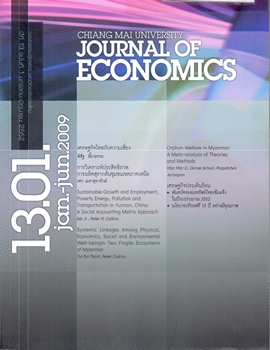Measuring poverty and income inequality under negative incomes: A case study from Myanmar
Keywords:
Welfare distribution negative income, poverty, Lorenz curves, Gini Coefficient, MyanmarAbstract
The purpose of this research article is to explore and discuss some possible methodological corrections to data from income and well-being surveys conducted in fragile eco-marketing systems. We seek to answer the question: ” How can inequality best be portrayed so that corrective policies, programs, and projects can be put into place that will help to equalize economic opportunities and outcomes? ” The data were collected in 2008 from 100 households each in Bagan, Central Myanmar and Kyaintali, Rakhine State on the Western coast of Myanmar. We challenge the use of traditional monetary welfare measures in two ways. Firstly, we demonstrate that negative income values pose significant problems to use of traditional equality measures, like the Gini coefficient. Secondly, the ranking between Bagan and Kyaintali regions provided by traditional monetary welfare measures reverses for some specific indicators such as land access . We argue that the latter more adequately reflect the situation of the poor rural population in Myanmar. Based on these results, we make policy recommendations for the two areas.Downloads
Issue
Section
License
All opinions and contents in the CMJE are the responsibility of the author(s). Chiang Mai University Journal of Economics reserves the copyright for all published materials. Papers may not be reproduced in any form without the written permission from Chiang Mai University Journal of Economics.
ข้อคิดเห็นที่ปรากฏและแสดงในเนื้อหาบทความต่างๆในวารสารเศรษฐศาสตร์มหาวิทยาลัยเชียงใหม่ ถือเป็นความเห็นและความรับผิดชอบโดยตรงของผู้เขียนบทความนั้นๆ มิใช่เป็นความเห็นและความรับผิดชอบใดๆของวารสารเศรษฐศาสตร์ มหาวิทยาลัยเชียงใหม่
บทความ เนื้อหา และข้อมูล ฯลฯ ในวารสารเศรษฐศาสตร์มหาวิทยาลัยเชียงใหม่ ถือเป็นลิขสิทธิ์เฉพาะของคณะเศรษฐศาสตร์มหาวิทยาลัยเชียงใหม่ หากบุคคลหรือหน่วยงานใดต้องการนำทั้งหมดหรือส่วนหนึ่งส่วนใดไปเผยแพร่ต่อหรือเพื่อกระทำการใดๆ จะต้องได้รับอนุญาตเป็นลายลักษณ์อักษร จากวารสารเศรษฐศาสตร์ มหาวิทยาลัยเชียงใหม่






